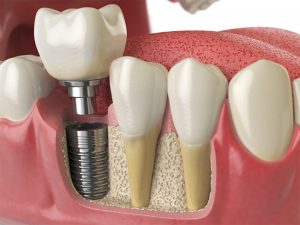OVERVIEW OF IMPLANT PLACEMENT
 What Are Dental Implants?
What Are Dental Implants?
A natural tooth consists of a root and a crown. If you compare natural teeth to implant supported replacement teeth, you’ll see they have the same basic parts. Both have a crown (the visible part used to chew food). Both have a root that holds the tooth securely under the gum and is anchored into the jaw. The difference is that the implant is made of titanium – the same time-tested material used by surgeons for artificial joints. When you lose a tooth, you lose both the root and the crown. To replace the tooth, the surgeon first replaces the root with a small dental implant.
At least three months are allowed for bone to heal and grow around the dental implant. The bone bonds with the titanium, creating a strong foundation for artificial teeth. A support post (abutment or healing collar) is then placed on the implant and a new replacement tooth (crown) is placed on top of the abutment, by your general dentist. In some cases a temporary replacement tooth can be attached to the implant immediately after it is placed.
 What Are Dental Implants?
What Are Dental Implants?
A natural tooth consists of a root and a crown. If you compare natural teeth to implant supported replacement teeth, you’ll see they have the same basic parts. Both have a crown (the visible part used to chew food). Both have a root that holds the tooth securely under the gum and is anchored into the jaw. The difference is that the implant is made of titanium – the same time-tested material used by surgeons for artificial joints. When you lose a tooth, you lose both the root and the crown. To replace the tooth, the surgeon first replaces the root with a small dental implant.
At least three months are allowed for bone to heal and grow around the dental implant. The bone bonds with the titanium, creating a strong foundation for artificial teeth. A support post (abutment or healing collar) is then placed on the implant and a new replacement tooth (crown) is placed on top of the abutment, by your general dentist. In some cases a temporary replacement tooth can be attached to the implant immediately after it is placed.
The procedure to place an implant takes 30 to 60 minutes for one implant and only 2 to 3 hours for multiple implants. The number of appointments and time required, vary from patient to patient. The surgeon will bring great precision and attention to the details of your case.
A local anesthetic will be administered to numb the area where the implant will be placed.
When you are comfortable, the periodontist makes a small incision in the gum tissue to reveal the bone, creating space using special instruments, and gently inserts the titanium implant. Sometimes the top of the implant is visible through the gum or the implant may be covered by the gum tissue.
Now the healing begins. The length of time varies from person to person, depending upon the quality and quantity of bone. You will be advised on your follow-up care and timing. After at least three months, the periodontist places an abutment (support post or healing collar) or a healing cap onto the implant. This allows gum tissue to mature and provides access to the implant.
How long your mouth needs to heal, before the crown can be placed by the general dentist, is determined by a variety of factors. Whether it’s one tooth or all of your teeth that are being replaced, your general dentist will complete the restoration by fitting the replacement tooth (crown) to the dental implant.
Implants are often placed several months after extraction. Sometimes, an implant can be placed immediately after extraction of a tooth. When infection or other problems with the bone are present, immediate implant placement is usually not the best treatment option.
If your tooth has been missing for some time, the adjacent support bone is likely to grow thinner and shrink. This occurs because the root of the natural tooth has to be present to stimulate the bone. As much as one third of your jaw’s thickness can be lost in the year following tooth extraction. If you are missing bone, you may benefit from having additional bone placed into the area. This ensures adequate support for the implant.
Most frequently, one implant per missing tooth is placed.
